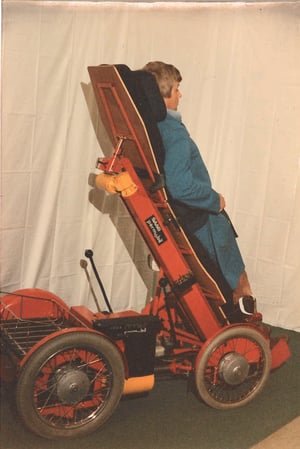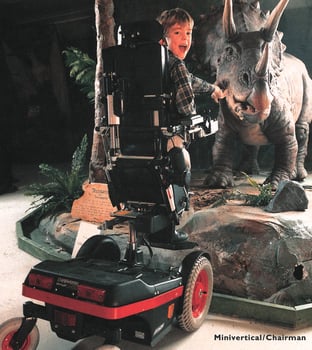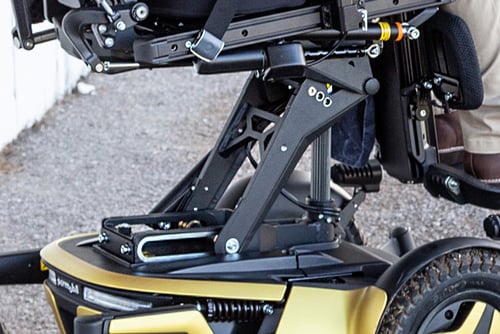The Corpus VS's ability to transition someone from sitting to standing with smoothness and grace is awe inspiring. While Permobil’s flagship seating system of is an innovative piece of complex rehabilitation technology, we cannot overlook the lessons we have learned over nearly 50 years of manufacturing standing power wheelchairs. What you all know today as the Corpus VS was an evolving journey of compassion, dedication, and a user-first mindset to provide the same technological advantages in the everyday lives of those who rely on wheeled mobility.
Lesson #1: End users need a full range of power seat functions.
While the first Permobil standing power wheelchair in 1977 was innovative, we quickly discovered that we couldn’t compromise on other power seat functions for standing.
In 2008, with the introduction of the Corpus VS, we accomplished our goal of giving our power wheelchair users full power seat functions and did away with the “either/or” option. Permobil’s power standing wheelchair system has continued to evolve, expanding to mid-wheel drive in 2023, providing more choice for wheelchair users who need standing. Today, our users have two options when choosing to stand in their power wheelchair: the F5 Corpus VS (front-wheel drive) or M Corpus VS (mid-wheel drive).

Lesson #2: People who use wheelchairs often require customized standing sequences.
The ability to personalize stand sequences to each individual is what makes the Corpus VS shine in the market. However, early on, standing power mobility did not offer this feature. Innovative at its time, our simple standing sequences gave our end users an “all or nothing” approach when it came to standing while in their wheelchair. Supine-to-stand was the first and only option for many years, and eventually sit-to-stand options were added.
In 2008, the introduction of the C500 VS with “smart actuators” was a pivotal moment in our standing history. It launched the first phase of programmable standing capabilities, starting from three predefined default sequences. In 2015, we launched the F5 Corpus VS, which took much of the guess work out of the programming.with With the F5 Corpus VS, we added atomatic powered support wheels for optimal stability. Permobil’s standing sequences can now be programmed faster and easier than ever before using the revolutionary QuickConfig wireless programming application.
Since its introduction in June 2023, QuickConfig has allowed clinicians and providers the ability to easily customize stand sequences tailored to meet individual needs.
Lesson #3: People who use wheelchairs desire ideal posture & function in all positions.
Nothing is worse than achieving wonderful postural control and increased function while seated, only to lose it when coming to a standing position. The challenge of maintaining and/or accommodating postural needs in both a seated and standing position is quite complex. While accomplishing different stand sequences, addressing the postural control and positioning of the individual took a lot longer than hoped.
In 1993, a mechanical linkage was designed to open the seat-to-back angle allowing the individual to more comfortably reach the standing position. Throughout the '90s and early 2000's this technology continued to evolve, culminating in 2015 with the addition of the 3rd generation (3G) Corpus seating system utilized with the power standing functionality.
At this point, we could truly claim that the Corpus VS provided standing without compromise (no more increased seat to floor height, limited tilt, or armrests being too high in standing!) This revolutionary technology could meet both the seated and standing needs of each individual, allowing them to maintain postural control for functional activities regardless of position.
Lesson #4: People who use wheelchairs expect versatile and modular equipment to accommodate them as their needs change.
Another lesson we have carried through nearly a half century of manufacturing standing power wheelchairs is that our wheelchair users and their needs consistently change. Our wheelchairs must adjust to postural needs throughout each day, as well as adapt to larger changes due to growth or a progressive diagnosis or condition over time. With a seating system that can support children through those weighing up to 300 pounds, fully programmable stand sequences including footplate height, andthe ability to adjust seat and backrest angles or elevate while standing, Permobil's standing power wheelchairs offer maximum flexibility for everyone.

Lesson #5: People who use wheelchairs value seamless integration of the seating system on the chassis.
Looking back at Permobil’s standing power wheelchairs over the years, you'll continually see a clean and simple aesthetic that Permobil is known for. You won’t see excessive wiring/cables, belts, or visible linkages hanging down. This is important not only for a clean look, but also for durability in the seating system. Hanging items can get caught or bound up, making it difficult for the chair to operate fully and safely.
A seamless integration of the seating system on the chassis provides greater confidence in all positions of the seat. There is no need to lock out suspension when standing or elevated because power standing wheelchair was designed as a system.This intentional design of the Corpus VS, along with all Permobil power products, is the culmination of years of design experience and excellence.

Lesson #6: People who use standing wheelchairs want to move around while standing.
The Corpus VS provides standing and full seat elevation for maximum functionality. fact, the current model allows seat elevation while standing which is helpful for reaching taller heights. Furthermore, once elevated or standing, it is imperative to be able to move around the environment to carry out functional tasks. Permobil’s stand and drive technology truly opens the world to individuals.
We introduced the ability to drive while standing with our very first standing power wheelchair in 1977. Continual advancements in our technology have enabled us to provide a better, more reliable stand and drive system. The M Corpus VS suspension allows for driving in the standing position and the F5 Corpus VS features automatically deploying support wheels. Neither of the chairs lock out the suspension, an unprecedented in the market today.

Lesson #7: People who use standing wheelchairs deserve knee supports that are comfortable.
The Corpus Ergo seat cushion as well as the Corpus back supports were both developed with input from a renowned physiotherapist specializing in ergonomic seating, Bengt Engstrom. This collaboration allowed our engineers to develop one of the most versatile and comfortable seating systems in the industry! Acquiring companies specializing in seating and positioning products, like ROHO and Comfort Company, further broadened our knowledge base of secondary supports for Corpus VS. In the first true collaboration between Permobil power and seating and positioning engineers, the new swing-away knee supports were created. These flexible and adjustable supports were designed for independence and integrate adjustable BOA® technology also used in the Comfort Acta-Relief.

As we’ve taken you on this standing journey, we wanted to take a moment to highlight another type of smart technology feature which comes standard on the F5 Corpus VS: Permobil Connect. Permobil Connect provides a remote platform that connects end users to their service provider and enables the use of the free MyPermobil app. MyPermobil communicates real-time status updates including battery range estimates, travel history, and seat position details directly to a client's smartphone to help them get even more out of their power wheelchair.
Permobil is excited to see how this technology will continue to evolve over the next 10 to 20 years and we are actively advocating for standing power wheelchair coverage. Click here to learn more about how you can join us and Advocate for More. Permobil will continue to bring the latest and greatest to the market as we Innovate for Individuals.

Ashley Detterbeck DPT, ATP, SMS
Clinical Education Manager
Ashley Detterbeck DPT, ATP, SMS received her Doctorate in Physical Therapy from the University of Minnesota in December 2006. She currently holds certification with RESNA as an Assistive Technology Provider and Seating and Mobility Provider. Detterbeck joined Permobil in 2017 as a Clinical Education Manager covering the Upper Midwest. Prior to joining Permobil, she spent 13 years with the Marshfield Clinic in Marshfield WI, where she ran the Seating and Mobility Clinic, participated in adult and pediatric gait based research, provided ongoing neurological care to both adults and pediatrics. With Permobil, Detterbeck is currently presenting educational programs to therapists and DME suppliers regarding seating, wheeled mobility, and pressure ulcer prevention.

Amy Morgan, PT, ATP
Director Product Management ‑ Power Wheelchairs
Amy has been involved in complex rehabilitation technology since beginning her career as a physical therapist in 2000. Amy’s clinical experience primarily includes outpatient and inpatient pediatric care at Cincinnati Children’s Hospital where she worked with a variety of patient populations. Additionally, Amy was the lead therapist in the Wheelchair/Seating Clinic and Comprehensive Neuromuscular Care Center. In 2007, she joined Permobil as the Pediatric and Standing Clinical Specialist/National Clinical Education Manager where she presented lectures both nationally and internationally and provided input to design for new products. Amy has also worked in Sales at Permobil as the Territory Sales Manager for central/southern Ohio where she earned top sales awards multiple years. She is now part of the Marketing organization as the Director of Product Management for Permobil’s power mobility product line.

